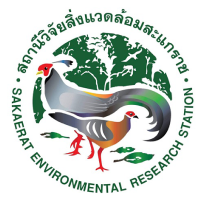Keywords :
Carbon Stock; Land Use; Natural Forest; Reforestation; Corn Cultivation
บทคัดย่อ :
Carbon storage and CO2 emissions were measured during May 2003-February 2004 in three
land use types in northeastern Thailand. These included a natural dry evergreen forest (DEF), a
reforestation planted with 16-years old Acacia mangium (AC) and a cornfield site (CF). The main
objective was to estimate and compare carbon stock as affected by land use type. On the area-basis, the
estimated of carbon storages in the upper 50 cm-layer of soil were 118, 66 and 57 ton C ha-1 in DEF, AC
and CF soils, respectively. The total carbon storages (standing biomass plus soil carbon, excluding
belowground biomass) were 418, 164 and 60 ton C ha-1 in DEF, AC and CF soils, respectively. At forest
site, majority of carbon was stored in the standing biomass (71% and 60% of total carbon storage at
DEF and AC site, respectively). At CF site, however, about 95% of carbon was stored in the soil. Total
net CO2 emission was not significantly different among these three sites (12-17 ton C ha-1 yr-1), presumably
due to large spatial and temporal variations. The results indicated that the amount and characteristics of
carbon storage differed significantly depending on land use type. Conversion of natural forest to
agriculture (after 16 years), in addition to loss of carbon stored in the standing biomass, might result in
about 50% loss of soil carbon in the upper 50 cm. On the other hand, reforestation for 16 years might
increased soil carbon by 14% (0.6 ton C yr-1) compared with a continuous cultivated soil (maize).
เอกสารอ้างอิง :
Lichaikul, N., Chidthaisong, A., Havey, N. W., & Wachrinrat, C. (2006). Carbon stock and net CO2 emission in tropical upland soils under different land use. Kasetsart Jounal (Nat. Sci.), 40, 382-394.



